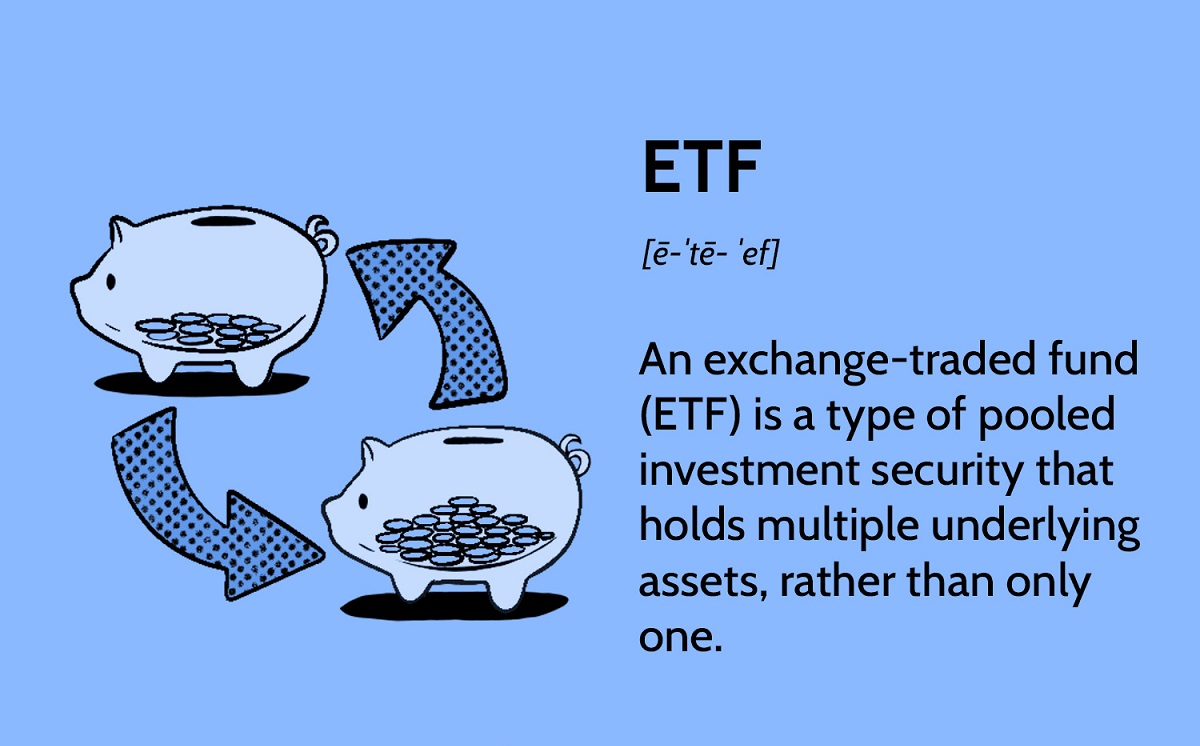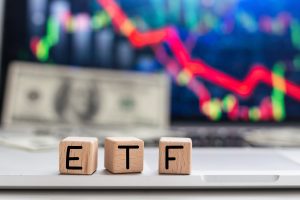Introduction
Welcome to the world of ETF investments! If you are looking for a way to diversify your investment portfolio, minimize risk, and potentially earn a solid return, ETFs (Exchange-Traded Funds) may be the solution you’ve been seeking. ETF investments have gained tremendous popularity among both seasoned investors and newcomers to the financial market, thanks to their unique features and benefits.
In this article, we will explore the ins and outs of ETF investments, providing you with a comprehensive overview of what they are, their advantages, different types of ETFs, how to invest in them, and considerations to keep in mind. By the end of this guide, you will have a clearer understanding of ETF investments and be equipped with the knowledge to make informed investment decisions.
But first, let’s briefly discuss what ETF investments entail. Essentially, an ETF is a type of investment fund that tracks the performance of a specific index, such as the S&P 500 or the NASDAQ. Unlike traditional mutual funds, ETFs are traded on stock exchanges and can be bought and sold throughout the trading day, just like individual stocks. This liquidity and flexibility make ETFs an attractive investment vehicle for both long-term investors and active traders.
ETFs offer a wide range of advantages, which we will delve into later in this article. Some of the key benefits include diversification across multiple assets, lower expense ratios compared to mutual funds, tax efficiency, and transparency in terms of holdings and performance. These features have made ETF investments increasingly popular among investors who are looking for flexibility, cost-effectiveness, and simplicity in managing their portfolios.
Before we get into the nitty-gritty details of ETF investments, it’s important to note that no investment is without risks. While ETFs offer numerous advantages, it’s crucial to understand the potential risks and consider your individual financial goals and risk tolerance before diving into any investment. Monitoring and managing your ETF investments is essential for long-term success.
Now that we’ve established the importance of ETF investments and the factors to consider, let’s explore the different types of ETFs available in the market and identify the best ways to invest in them for your financial needs and goals.
What are ETF Investments?
ETFs, or Exchange-Traded Funds, are investment vehicles that aim to track the performance of a specific index, sector, commodity, or asset class. They offer investors a way to gain exposure to a diversified portfolio of securities, without the need to individually select and manage each security.
Unlike traditional mutual funds, which are priced at the net asset value (NAV) at the end of each trading day, ETFs trade on stock exchanges throughout the trading day, similar to individual stocks. This means that the price of an ETF can fluctuate throughout the day based on supply and demand, offering investors the opportunity to buy or sell shares at any time.
ETFs are designed to provide investors with a cost-effective and efficient way to access a specific market or asset class. They offer diversification, which can help reduce risk by spreading investments across a wide range of securities. This diversification can be particularly beneficial for investors who may not have the time, resources, or expertise to individually research and select a diversified portfolio of securities.
One of the key advantages of ETF investments is their transparency. Most ETFs disclose their holdings on a daily basis, allowing investors to see exactly what securities the fund holds. This transparency enables investors to make informed decisions based on the fund’s underlying assets.
ETFs are available in a wide range of asset classes and investment strategies. Some ETFs track broad market indexes such as the S&P 500, while others focus on specific sectors, commodities, or international markets. For example, there are ETFs that track the performance of technology stocks, gold, emerging markets, or bonds.
Furthermore, ETFs also offer investors the ability to employ various investment strategies, such as leveraged or inverse ETFs. Leveraged ETFs aim to provide a multiple of the daily return of an underlying index, while inverse ETFs aim to provide the inverse or opposite of the daily return of an underlying index. These types of ETFs can be used by investors who want to take advantage of short-term market movements or hedge against potential losses.
In summary, ETF investments are a popular investment vehicle that provides investors with exposure to a diversified portfolio of securities, transparency, liquidity, and flexibility. They offer a cost-effective way to gain exposure to specific markets or asset classes and can be used to implement different investment strategies. Understanding the features and benefits of ETF investments is essential for investors seeking to diversify their portfolios and achieve long-term financial goals.
Advantages of ETF Investments
ETF investments offer a range of advantages that make them an attractive option for investors. Here are some key benefits of investing in ETFs:
- Diversification: ETFs provide instant diversification by investing in a basket of securities. This helps to spread risk across different companies, sectors, or asset classes. Investors can gain exposure to a wide range of assets through a single investment.
- Liquidity: ETFs are traded on stock exchanges throughout the trading day, making them highly liquid. Investors can buy or sell ETF shares at any time during market hours, providing flexibility and the ability to react quickly to market changes.
- Transparency: Most ETFs disclose their holdings on a daily basis, allowing investors to see exactly what securities the fund owns. This transparency provides insight into the underlying assets and helps investors make informed decisions.
- Low Costs: ETFs generally have lower expense ratios compared to mutual funds. This is because ETFs are passively managed and aim to replicate the performance of an index, rather than actively selecting securities. The lower expenses result in higher returns for investors.
- Tax Efficiency: ETFs are structured in a way that can minimize capital gains taxes. When an investor sells an ETF, they are generally only subject to capital gains tax on the portion of the fund they sell, rather than the entire portfolio. Additionally, ETFs have fewer taxable events compared to mutual funds, reducing the potential tax burden for investors.
- Flexibility: ETFs offer investors the ability to implement different investment strategies. They can be bought or sold on margin, used in options trading, or employed in short-selling strategies. ETFs also offer the opportunity to invest in specific sectors, styles, or geographic regions, allowing investors to tailor their portfolios to their preferences.
These advantages have contributed to the growing popularity of ETF investments. The ability to achieve diversification, flexibility, and transparency at a lower cost has made ETFs a favored investment choice among both individual and institutional investors.
However, it’s important to note that while ETFs provide numerous advantages, they are not without risks. Investors should carefully consider their investment objectives, risk tolerance, and research the specific ETFs they are interested in before investing.
Types of ETFs
ETFs come in various types, each designed to track different indexes, sectors, or investment strategies. Understanding the different types of ETFs can help investors choose the ones that align with their investment goals. Here are some common types of ETFs:
- Equity ETFs: These ETFs focus on tracking the performance of a specific equity index, such as the S&P 500, Dow Jones Industrial Average, or a specific sector index. Equity ETFs provide investors with exposure to a diversified portfolio of stocks, allowing them to participate in the potential growth of the overall market or a specific sector.
- Bond ETFs: Bond ETFs invest in a portfolio of fixed-income securities such as government bonds, corporate bonds, or municipal bonds. Bond ETFs provide investors with exposure to the bond market, allowing them to earn income through interest payments and potentially benefit from capital appreciation.
- Commodity ETFs: Commodity ETFs track the performance of commodities such as gold, silver, oil, or agricultural products. These ETFs provide investors with a way to gain exposure to commodity prices without physically owning the underlying assets. Commodity ETFs can be used as a hedge against inflation or as a way to diversify a portfolio.
- International ETFs: International ETFs invest in securities of foreign markets and provide investors with exposure to global markets. These ETFs track international indexes or focus on specific regions or countries. International ETFs allow investors to diversify their portfolios and potentially benefit from the growth of economies outside their home country.
- Sector ETFs: Sector ETFs track the performance of a specific sector of the economy, such as technology, healthcare, energy, or financial services. These ETFs provide investors with targeted exposure to industries or sectors that they believe will outperform the broader market.
- Smart Beta ETFs: Smart Beta ETFs combine elements of both active and passive investing. These ETFs use alternative index-weighting methodologies to select and weight securities within the fund. Smart Beta ETFs aim to outperform traditional market-weighted indexes by emphasizing factors such as value, growth, size, or volatility.
- Inverse ETFs: Inverse ETFs are designed to profit from a decline in the value of an underlying index or asset class. These ETFs use derivatives to generate returns opposite to the performance of the targeted index. Inverse ETFs can be used for hedging purposes or to take advantage of bearish market conditions.
It’s important to note that this is not an exhaustive list of all types of ETFs. There are many other specialized ETFs available in the market, catering to specific investment strategies or asset classes.
When considering investing in ETFs, it’s crucial to understand the specific objectives, holdings, and risks associated with each ETF. Evaluating the performance, expense ratios, and historical tracking accuracy of an ETF is also essential in making informed investment decisions.
Now that we have explored the various types of ETFs, let’s move on to the next section, which covers the different ways to invest in ETFs.
How to Invest in ETFs
Investing in ETFs is relatively simple and accessible for both experienced investors and newcomers to the financial market. Here are the common ways to invest in ETFs:
- Through a Brokerage Account: The most common method of investing in ETFs is through a brokerage account. Investors can open an account with a brokerage firm and buy or sell ETF shares through the brokerage’s online trading platform. It provides the flexibility to trade ETFs in real-time and allows investors to take advantage of market fluctuations.
- Investment Apps: There are several investment apps available that allow individuals to invest in ETFs with ease. These apps typically provide a user-friendly interface, low minimum investment requirements, and access to a variety of ETFs to choose from.
- Employer-Sponsored Retirement Plans: Some employer-sponsored retirement plans, such as 401(k) or 403(b) plans, offer ETFs as investment options. Investors can contribute a portion of their salary to these plans and allocate their contributions towards ETFs. This provides the advantage of tax-deferred growth and potentially lower expenses through the employer’s plan.
- Robo-Advisors: Robo-advisors are automated investment platforms that use algorithms to create and manage investment portfolios for individuals. Many robo-advisors offer ETF portfolios as part of their investment strategies. Investors can sign up with a robo-advisor, provide their investment goals and risk tolerance, and let the platform automate their ETF investments.
Regardless of the method chosen, investors should consider a few factors before investing in ETFs:
- Research and Due Diligence: It’s important to conduct thorough research on the ETFs you are considering for investment. Evaluate the ETF’s performance, expense ratio, tracking accuracy, and the underlying index or assets it tracks.
- Diversification: Consider the level of diversification the ETF offers and whether it aligns with your investment goals. Ensure that the ETF’s holdings are spread across different companies, sectors, or asset classes to mitigate risk.
- Expense Ratios: Compare the expense ratios of different ETFs to ensure you’re getting good value for your investment. Lower expense ratios can significantly impact your investment returns over time.
- Trading Costs: Be aware of any trading costs or commissions associated with buying or selling ETF shares. Some brokerages offer commission-free trading for certain ETFs, which can be more cost-effective for investors.
- Tax Considerations: Understand the potential tax implications of investing in ETFs. While ETFs are generally tax-efficient, it’s important to be aware of any distributions or capital gains that may affect your tax liability.
By considering these factors and investing with a well-thought-out strategy, investors can make informed decisions about their ETF investments and work towards achieving their financial goals.
Choosing the Right ETF
With the wide variety of ETFs available in the market, choosing the right one can seem overwhelming. However, by considering a few key factors, investors can find the ETF that aligns with their investment goals and preferences. Here are some important factors to consider when choosing an ETF:
- Investment Objective: Determine your investment objective or goal. Are you looking for broad market exposure, sector-specific exposure, or exposure to a particular asset class? Understanding your investment objective will help narrow down the selection of ETFs that meet your needs.
- Underlying Index: Examine the index that the ETF tracks. Evaluate its composition and methodology. Ensure that the index aligns with your investment strategy and provides exposure to the market segment you are interested in.
- Performance: Review the historical performance of the ETF. Look for consistent returns over time and compare its performance against its benchmark index or similar ETFs in the same category. However, keep in mind that past performance is not a guarantee of future results.
- Expense Ratio: Consider the expense ratio of the ETF. It represents the annual fee charged by the fund for managing the portfolio. Lower expense ratios are generally favorable, as they can have a significant impact on your investment returns in the long run.
- Liquidity: Assess the liquidity of the ETF by examining its average daily trading volume and bid-ask spread. Higher trading volume and tight bid-ask spreads indicate better liquidity, allowing you to buy or sell shares without significant price fluctuations.
- Tracking Accuracy: Evaluate the ETF’s tracking accuracy. This refers to how closely the ETF’s performance aligns with the index it aims to replicate. Look for ETFs that have a low tracking error and closely track their underlying index.
- Provider Reputation: Consider the reputation and credibility of the ETF provider. Look for established providers with a track record of managing ETFs effectively. Reputable providers often have a history of launching successful ETFs and maintaining transparency with investors.
- Asset Size: Examine the size of the ETF in terms of assets under management (AUM). A larger AUM can indicate the popularity and stability of the ETF. However, keep in mind that smaller ETFs may offer unique investment opportunities or niche exposures.
It’s important to note that no single ETF will meet all investors’ needs. Each investor’s preferences and risk tolerance may differ. Therefore, it’s essential to conduct thorough research, compare different ETFs, and prioritize the factors that are most important to your investment strategy.
Additionally, diversification can be achieved by combining multiple ETFs that complement each other. This allows you to build a well-rounded portfolio that aligns with your investment objectives and risk tolerance.
Remember that investing in ETFs involves risks, and it’s important to carefully assess each ETF’s prospects and consult with a financial advisor if needed. By choosing the right ETFs, investors can position themselves for potential growth and achieve their investment goals.
Understanding ETF Performance
When investing in ETFs, it’s essential to understand how to evaluate and interpret their performance. Here are some key aspects to consider when assessing the performance of an ETF:
Price Performance: The most obvious aspect of an ETF’s performance is its price movement over time. Monitoring the price performance allows investors to gauge the potential returns or losses of their investment. This can be done by comparing historical price charts, analyzing trends, and identifying patterns.
Tracking Error: Tracking error measures the deviation of an ETF’s returns from the underlying index it aims to replicate. A lower tracking error indicates that the ETF closely follows the index’s performance. However, it’s important to note that a certain level of tracking error is expected due to factors such as fees, trading costs, and sampling methodologies employed by the fund.
Yield and Dividends: Some ETFs provide income through dividends or interest payments generated by the underlying assets. Understanding the yield and dividend distribution policies of an ETF is crucial, especially for income-focused investors. It’s important to assess the stability and consistency of the ETF’s dividend payments and compare them to similar income-oriented investments.
Expense Ratio: The expense ratio of an ETF represents the annual fees charged by the fund for managing the portfolio. Higher expense ratios can eat into investment returns over time, while lower expense ratios can have a positive impact on net returns. Comparing the expense ratios of similar ETFs can help investors identify cost-efficient options.
Risk Factors: ETF performance should be evaluated in the context of the associated risks. Consider the specific risks associated with the underlying assets or strategies of the ETF, such as market risk, sector risk, interest rate risk, or currency risk. Understanding these risks helps investors assess the potential volatility and downside potential of the ETF.
Comparison to Benchmark: Comparing the performance of an ETF to its benchmark index or a relevant index within its asset class is crucial. This comparison provides insight into whether the ETF has outperformed or underperformed relative to its underlying benchmark. However, it’s important to consider the tracking error and market conditions when evaluating relative performance.
Long-Term Performance: Evaluate the long-term performance of an ETF to determine its ability to achieve its investment objectives. Analyzing the performance over multiple market cycles can provide a more comprehensive view of the ETF’s performance consistency and potential for future growth.
It’s important to note that past performance is not indicative of future results. While historical performance is a valuable tool for evaluating an ETF’s performance, it cannot guarantee future returns. It’s crucial to conduct thorough research, understand the investment strategy and associated risks, and consider your own investment objectives and risk tolerance when assessing an ETF’s performance.
In summary, understanding ETF performance involves analyzing price movement, tracking error, yield and dividends, expense ratios, risk factors, and comparing the ETF to its benchmark index. By evaluating these factors, investors can gain insights into an ETF’s performance and make informed decisions that align with their investment goals.
Risks and Considerations of ETF Investments
While ETFs offer numerous advantages, it’s crucial to be aware of the risks and considerations associated with these investments. Understanding these factors will help investors make informed decisions and effectively manage their ETF portfolios. Here are some important risks and considerations to keep in mind:
Market Risk: ETFs are subject to market risk, which means their value can fluctuate due to changes in the overall market conditions. Factors such as economic conditions, geopolitical events, interest rates, or investor sentiment can impact the performance of ETFs. It’s important to be prepared for potentially significant price fluctuations and volatility.
Liquidity Risk: While ETFs are generally highly liquid, there can be instances of reduced liquidity, especially for ETFs with lower trading volumes or those tracking less liquid securities. This can lead to wider bid-ask spreads and difficulty in executing transactions at desired prices. Investors should consider the liquidity of an ETF before investing, especially for larger or less liquid ETFs.
Tracking Error: Despite their aim to replicate the performance of an underlying index, ETFs can have tracking errors. This deviation can be caused by factors such as fees, trading costs, sampling methodologies, or adjustments made by the fund. Investors should monitor the tracking error of an ETF to assess its ability to closely follow the index it tracks.
Counterparty Risk: Some ETFs use derivatives or engage in securities lending to achieve their investment objectives. This introduces counterparty risk, meaning there is a risk that the counterparty to these transactions may fail to fulfill their obligations. Investors should evaluate the counterparty risk associated with an ETF and consider the credit quality and reputation of the counterparties involved.
Expense Ratios: While ETFs generally have lower expense ratios compared to mutual funds, it’s important to consider the fees associated with an ETF. High expense ratios can erode investment returns over time. Investors should carefully evaluate the expense ratios of different ETFs and assess the value they provide in relation to their investment objectives.
Tax Considerations: ETFs can have tax implications, including capital gains taxes on distributions and potential tax inefficiencies associated with fund turnover. Investors should be aware of these potential tax consequences and consider their individual tax situations when investing in ETFs. Consulting with a tax advisor can help better understand the tax implications of ETF investments.
Reinvestment of Dividends: Some ETFs may distribute dividends, which can be reinvested automatically or received as cash. Investors should consider their preferences and the potential impact of dividend reinvestment on their investment strategy. Reinvesting dividends may result in additional transaction costs or tax obligations.
Single ETF Concentration Risk: Investing heavily in a single ETF can expose investors to specific risks associated with that ETF, such as concentration in a particular sector, country, or asset class. Diversification across multiple ETFs or asset classes can mitigate this risk and help spread exposure.
It’s important for investors to carefully assess these risks and considerations in the context of their investment goals, risk tolerance, and overall portfolio strategy. Being aware of these factors will allow investors to make informed decisions, implement risk management strategies, and potentially enhance their long-term investment outcomes.
Tax Implications of ETF Investments
When considering ETF investments, it’s important to understand the tax implications associated with these investments. While ETFs are generally known for their tax efficiency, there are several factors that investors should be aware of to effectively manage their tax obligations. Here are some key tax considerations for ETF investments:
Capital Gains Taxes: When you sell shares of an ETF at a profit, you may be subject to capital gains taxes. The tax rate depends on the holding period of the ETF shares. If held for less than a year, short-term capital gains tax rates apply, which are typically higher than long-term capital gains tax rates, applied to holdings of one year or longer.
Dividend Distributions: Many ETFs provide dividends to their investors, which can be subject to income tax. Dividends can be classified as either qualified or non-qualified, with qualified dividends benefiting from lower tax rates. The classification depends on various factors, including the underlying assets held by the ETF and the duration of holding the ETF shares.
Reinvested Dividends: If you choose to reinvest dividends received from an ETF, these reinvested dividends are still considered taxable income in the year they are received. Even though you are not receiving cash, you are still liable for any applicable taxes on the reinvested dividends.
Capital Gains Distributions: Some ETFs distribute capital gains to investors based on their trading activities within the fund. These capital gains distributions can result in taxable income for investors, even if they have not sold any of their ETF shares. It’s important to understand the potential tax liability associated with capital gains distributions and plan accordingly.
Tax-Efficient ETF Structures: ETFs are generally structured in a tax-efficient manner. Authorized participants create or redeem ETF shares in exchange for the underlying securities, which can minimize taxable events within the fund. This creation and redemption process helps reduce capital gains distributions compared to traditional mutual funds.
Tracking of Cost Basis: Unlike mutual funds, ETFs do not calculate the cost basis for investors. It is the responsibility of the investor to keep track of the acquisition cost and any adjustments made through additional purchases or reinvested dividends. Accurate tracking of the cost basis is crucial for calculating the capital gains or losses when selling ETF shares.
Tax-Loss Harvesting: ETF investments can provide opportunities for tax-loss harvesting. This strategy involves selling investments that have experienced losses to offset capital gains and potentially reduce taxes. It’s important to consult with a tax advisor to understand the rules and potential benefits of tax-loss harvesting.
Individual Tax Situation: Each investor’s tax situation is unique, and tax implications can vary based on factors such as income level, filing status, and jurisdiction. It’s crucial to consider your individual tax circumstances and consult with a tax professional to assess and manage the tax implications of your ETF investments.
Understanding the tax implications of ETF investments is crucial for managing your overall tax liability and maximizing your after-tax returns. By being aware of these tax considerations, investors can effectively plan, make informed decisions, and potentially minimize the impact of taxes on their ETF investments.
Conclusion
ETFs offer investors a versatile and efficient way to access a wide range of assets, diversify their portfolios, and potentially achieve their investment goals. Throughout this guide, we have explored the various aspects of ETF investments to equip investors with the necessary knowledge to make informed decisions.
We started by understanding the basics of ETF investments, including their structure, liquidity, and transparency. We then delved into the advantages of ETF investments, such as diversification, low costs, tax efficiency, and flexibility. It’s crucial to consider these advantages when evaluating ETFs as part of an investment strategy.
Next, we explored different types of ETFs, including equity ETFs, bond ETFs, commodity ETFs, international ETFs, sector ETFs, smart beta ETFs, and inverse ETFs. Understanding the differences between these types of ETFs helps investors select the ones that align with their investment objectives and preferences.
We then discussed how to invest in ETFs, covering methods such as brokerage accounts, investment apps, employer-sponsored retirement plans, and robo-advisors. By considering factors like research, diversification, expenses, and taxes, investors can choose the most suitable method for their investment needs.
Additionally, we examined the importance of choosing the right ETF, including aspects like investment objective, tracking error, expense ratio, liquidity, and provider reputation. By carefully considering these factors, investors can select ETFs that align with their investment goals and risk tolerance.
Risks and considerations are an essential part of any investment strategy. We discussed potential risks associated with ETF investments, including market risk, tracking error, liquidity risk, and tax implications. Understanding these risks helps investors mitigate potential downsides and make informed decisions.
Lastly, we explored the tax implications of ETF investments, including capital gains taxes, dividend distributions, reinvested dividends, and tax-efficient structures of ETFs. With proper tax planning and understanding, investors can efficiently manage their tax obligations and potentially enhance their after-tax returns.
It’s important to emphasize that individual investment goals, risk tolerance, and tax situations vary. It’s advisable to conduct further research, consult with financial professionals, and evaluate personal circumstances before making any investment decisions.
In conclusion, ETF investments can play a significant role in a well-diversified portfolio, offering numerous advantages such as diversification, liquidity, transparency, and flexibility. By understanding the different types of ETFs, methodologies for investment, risks, and tax implications, investors can harness the potential benefits of ETFs while effectively managing their investments for long-term success.

























